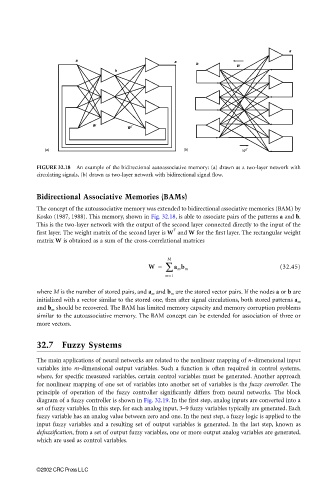Page 969 - The Mechatronics Handbook
P. 969
0066_Frame_C32.fm Page 19 Wednesday, January 9, 2002 7:54 PM
a
a a
b
W
b
W
W T
(a) (b) W T
FIGURE 32.18 An example of the bidirectional autoassociative memory: (a) drawn as a two-layer network with
circulating signals, (b) drawn as two-layer network with bidirectional signal flow.
Bidirectional Associative Memories (BAMs)
The concept of the autoassociative memory was extended to bidirectional associative memories (BAM) by
Kosko (1987, 1988). This memory, shown in Fig. 32.18, is able to associate pairs of the patterns a and b.
This is the two-layer network with the output of the second layer connected directly to the input of the
T
first layer. The weight matrix of the second layer is W and W for the first layer. The rectangular weight
matrix W is obtained as a sum of the cross-correlational matrices
M
W = ∑ a m b m (32.45)
m=1
where M is the number of stored pairs, and a m and b m are the stored vector pairs. If the nodes a or b are
initialized with a vector similar to the stored one, then after signal circulations, both stored patterns a m
and b m should be recovered. The BAM has limited memory capacity and memory corruption problems
similar to the autoassociative memory. The BAM concept can be extended for association of three or
more vectors.
32.7 Fuzzy Systems
The main applications of neural networks are related to the nonlinear mapping of n-dimensional input
variables into m-dimensional output variables. Such a function is often required in control systems,
where, for specific measured variables, certain control variables must be generated. Another approach
for nonlinear mapping of one set of variables into another set of variables is the fuzzy controller. The
principle of operation of the fuzzy controller significantly differs from neural networks. The block
diagram of a fuzzy controller is shown in Fig. 32.19. In the first step, analog inputs are converted into a
set of fuzzy variables. In this step, for each analog input, 3–9 fuzzy variables typically are generated. Each
fuzzy variable has an analog value between zero and one. In the next step, a fuzzy logic is applied to the
input fuzzy variables and a resulting set of output variables is generated. In the last step, known as
defuzzification, from a set of output fuzzy variables, one or more output analog variables are generated,
which are used as control variables.
©2002 CRC Press LLC

